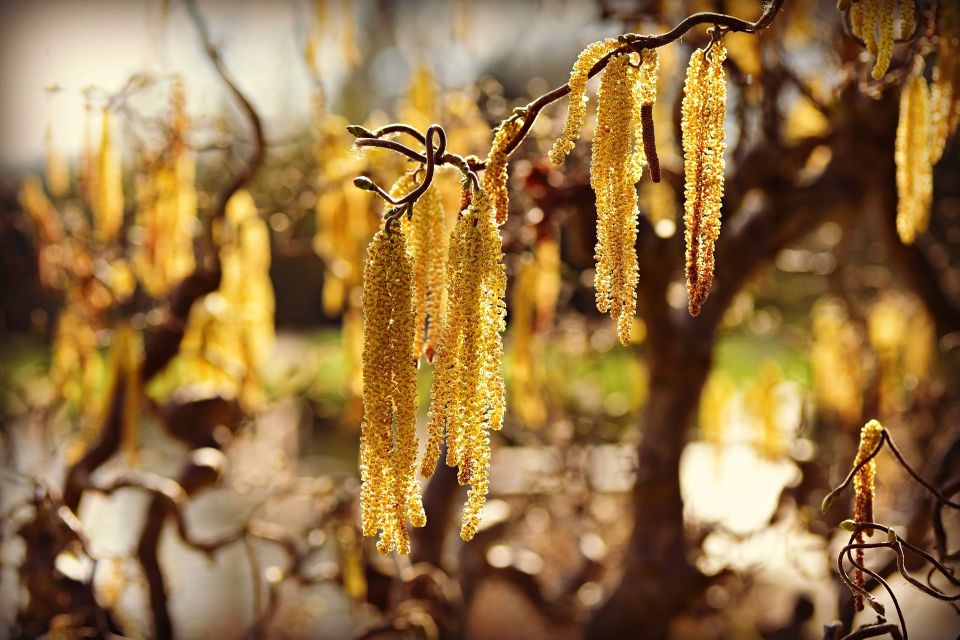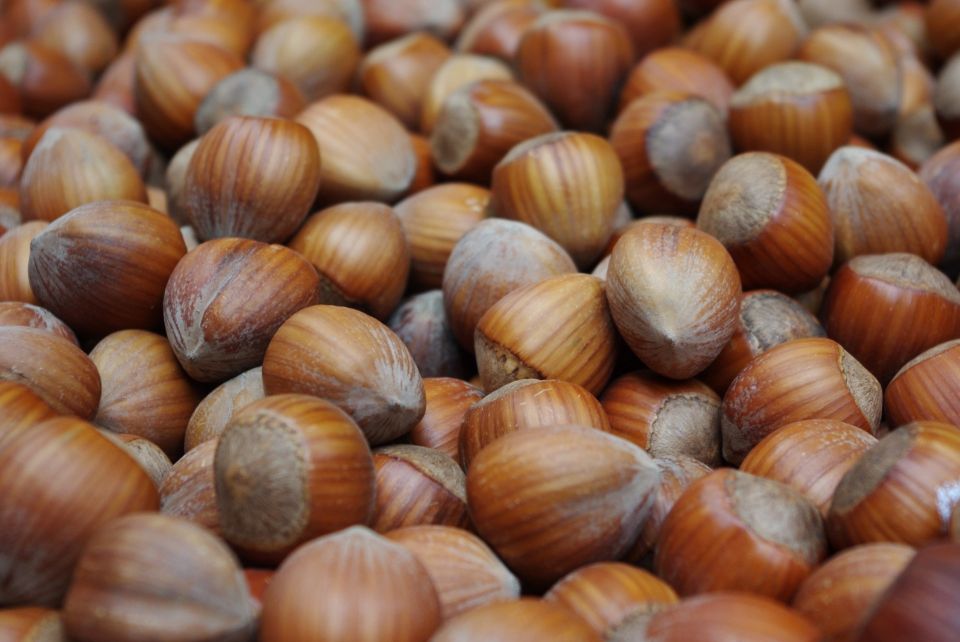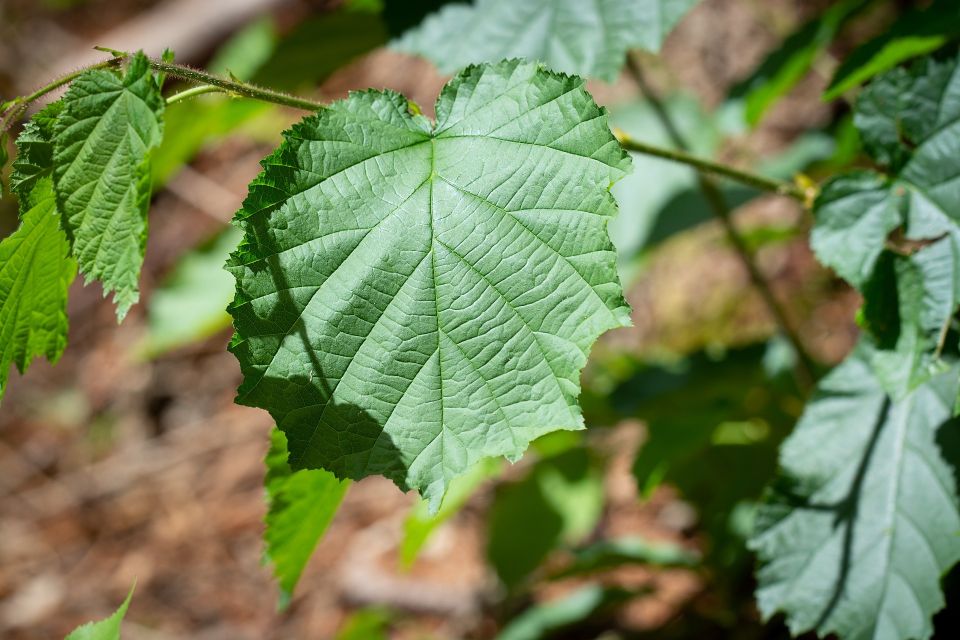Intreeducing: the helpful hazel

Although small and easy to overlook, that hazel has many powers. It's willowy, nutritious, crafty and has a fiery past.
Latin name: Corylus avellana
Like Prometheus, the hazel gives the gifts of hearth and fire. Abundant, ever present, once a vital resource for industry and a fundamental building block in the day to day lives of ordinary people.
In the midst of winter, the cheerful yellow catkins hang, known as lambs’ tails, they promise that winter’s hold won’t last, appearing as early as December or January. When spring arrives, hazel dons finery of fresh lime green oval leaves, soft and fuzzy with downy hairs.
The hazel has been an integral part of human life from ancient times, providing sustenance through its delicious nuts and wood for everyday needs. Its death-defying ability to grow after being cut right back became a fundamental part of how woods in this country provided the basic housing and living materials for ordinary people as well as organised industry. Using the process of coppicing, people living and working in the woods created a forest environment that sustained both humans and nature.
This forgotten way of life is starting to make a comeback as we begin to see that our woods need us as much as we need them, and the hazel is at the heart of it.
How to spot it
Hazel is monoecious, meaning that both male and female flowers are found on the same tree, but hazel flowers must be wind pollinated by pollen from other hazel trees. This is what most likely causes pesky hay fever at this time of year, but we can forgive the hazel, it’s a beauty after all. The small grey male catkins appear on the bare twigs as early as October or November and then by February they lengthen into the fluffy looking golden pollen laden ‘lamb’s tails’. The female parts look completely different and are tiny, crimson spiky flowers near the leaf buds. The hairy leaves are oval, toothed with a pointed tip and turn yellow in the autumn before joining other falling leaves.
The nut falls out of the husk when ripe, about 7 to 8 months after pollination. The kernel of the seed is edible and used raw or roasted, or ground into a paste. The seed has a thin, dark brown skin, which sometimes is removed before cooking. Hazelnuts are rich in protein, monounsaturated fat, vitamin E, manganese, and numerous other essential nutrients.
Hazel is a small, shrubby tree it’s found in a variety of habitats, such as woodlands and grasslands. Hazel has shiny, brown bark. It likes a mild climate and grows well as part of the understorey of a woodland. This is the layer of vegetation under the main canopy of a forest. It can grow up to 15m if left uncut, but usually it isn’t left to develop into a tree and is shrubbier. Left to its own devices it can live for around 70 years, but when coppiced it can live for much longer.

Hazel and humans
Humans and hazel trees have an ancient symbiotic relationship. Archaeological evidence from pollen analysis has shown there was a rapid expansion in the range of hazel during the Mesolithic period (from 11,000 to 6,000 years ago). As the nuts are too large to be moved large distances quickly by small mammals, this suggests that Mesolithic peoples may have transported the nuts with them as a food source, and so helped the tree spread to new areas.
This relationship really came into its own with coppicing, a traditional method of woodland management. It uses the ability of many species of trees to put out new shoots from their stump or roots if cut down. In a coppiced wood, or copse, young tree stems are repeatedly cut down to near ground level, known as a stool. New growth emerges and after a number of years, the coppiced tree is harvested and the cycle begins again. Coppicing allows the shrub to constantly renew itself and so it can live for much longer than usual. It maintains trees at a juvenile stage, and a regularly coppiced tree will never die of old age; some coppice stools may therefore reach immense ages. The age of a stool may be estimated from its diameter, and some are so large—perhaps as much as 5.4 metres (18 ft) across—that they are thought to have been continually coppiced for centuries.
Hazel has been coppiced for 4,000 years, with the timber used in many different ways. In the past when a countryman wanted a piece of wood this was usually provided by his hazel copse. One seventh of the wood was cut each year to give a constant supply of poles for firewood. Poles were also used for wattle (canes woven into a lattice pattern) to make fencing, hurdles and the foundation of wattle-and-daub walls for houses. It was even used for the frames of traditional coracle boats, important for fishing and crossing rivers. Hazel is still used today in crafts like basket making, screens and even bean poles. A small hazel coppice industry still survives today.
Coppicing may seem destructive, but the opposite is true! The Hazel is still living and grows back and is left to grow back for around 7 years or so. Over thousands of years this process created a unique habitat that supported a variety of wildlife. Nowadays coppicing is making a comeback as a woodland management strategy to open up the forest and increase the diversity of habitat so that different types of plants and animals can thrive. It also creates an opportunity for traditional woodland crafts that have been dying out to make a resurgence such as greenwood work and charcoal making.
In the 16th and 17th centuries the technology of charcoal iron production became widely established in England, continuing in some areas until the late 19th century. Coppices provided wood for charcoal before coal was economically significant in metal smelting. With the coppice style of management, wood could be provided for those growing industries indefinitely, at least in principle. This was so important that Henry VIII set out standards for wood management so enough of the right sort of wood was continuously available and maintained. Back in the day, woods weren’t quiet places, but hubs of industry and action. The woodland provided not only the small material from the coppice but also a range of larger timber for jobs like house building, bridge repair, cart-making and so on.
In the 18th century coppicing in Britain began a long decline. This was brought about by the erosion of its traditional markets. Firewood was no longer needed for domestic or industrial uses as coal and coke became easily obtained and transported, and wood as a construction material was gradually replaced by newer materials. Coppicing died out first in the north of Britain and steadily contracted towards the south-east until by the 1960s active commercial coppice was heavily concentrated in Kent and Sussex.
A minority of these woods are still operated for coppice today, often by conservation organisations, producing material for hurdle-making, thatching spars, local charcoal-burning or other crafts.

Hazel’s gifts to wildlife
Hazelnuts are a favourite food of Grey Squirrels, Dormice and Wood Mice, and some small mammals will cache their finds, storing them in burrows or old birds' nests. Large birds also eat them.
Coppicing is very good for wildlife because it opens the woodland floor to more sunlight and creates a diverse environment that species adapted to open woodland can inhabit. After cutting, the increased light allows existing woodland-floor vegetation such as bluebell, anemone, lesser celandine, dog violets and primrose to grow vigorously. Often brambles grow around the stools, encouraging insects, or various small mammals that can use the brambles as protection from larger predators. Woodpiles (if left in the coppice) encourage insects such as beetles to come into an area. The open area is then colonised by many animals such as nightingale, European nightjar and fritillary butterflies. As the coppiced hazel grows the canopy closes and it becomes unsuitable for these animals again—but in an actively managed coppice there is always another recently cut area nearby, and the populations can move around, following the coppice management.
Sadly, most British coppices have not been managed in this way for many decades. The coppice stems have grown tall (the coppice is said to be over stood), forming a heavily shaded woodland of many closely spaced stems with little ground vegetation. The open-woodland animals survive in small numbers along woodland rides or not at all, and many of these once-common species have become rare.
A mix of coppicing, scrub-cutting, ride maintenance and non-intervention all help woodland wildlife to thrive.
Hazel is the ideal coppice tree, it produces a cluster of straight flexible stems that can be harvested. The stems are able to regenerate quickly when cut. A typical coppice cycle might be anything from 7-15 years for hazel.
Myth and folklore
Hazel is associated with wisdom and inspiration. This sacred tree is said to be cloaked in a powerful magic which can imbue those who eat its fruit.
There’s a story of nine magical hazel trees which were said to once line the borders between the human world and the realm of the gods; these hazel trees bore branches laden heavy with fruit and their nuts would often fall into a nearby stream, where they would be consumed by the salmon. After eating the hazelnuts, the fish would gain all the knowledge of the world and came to be known as the Salmon of Wisdom! Bright, glistening spots appeared on the sides of the salmon to show that they had been blessed by the Magical hazel trees. Those who ate the hazelnuts (or the fish) were said to gain prophetic abilities and live a life full of wisdom!
In Greek mythology, Hermes (messenger of the gods and himself the god of border crossings) was said to carry a staff made from a hazel tree to aid him in his travels through the human and spirit realms. Hermes’s Roman equivalent, Mercury, also carried a hazel staff which bestowed him with great wisdom.
In ancient Rome, hazel wood was used to make magical wands and its branches were offered as symbols of happiness. Because of its association with fertility, in medieval France the plant was given as a special gift at weddings. People in medieval Italy even believed that magicians could communicate with the dead using hazel branches!
Whether you would like some wisdom from eating yummy hazel nuts or want to learn how to weave a basket, hazel can help you out. Why not be inspired by this unassuming master crafter and try one of the ancient crafts associated with hazel, like basket making? And keep an eye out for those ‘lamb’s tails’ and the fresh spring greenery of all those hazel shrubs around us.
Donate to Trees for Cities and together we can help cities grow into greener, cleaner and healthier places for people to live and work worldwide.
Donate